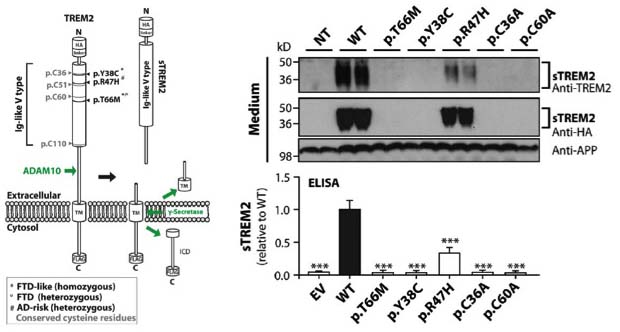TREM2 mutations implicated in neurodegeneration impair cell surface transport and phagocytosis
Sci Transl Med 2 July 2014: Vol. 6, Issue 243, p. 243ra86
| Authors/Editors: |
G. Kleinberger Y. Yamanishi M. Suarez-Calvet E. Czirr E. Lohmann E. Cuyvers H. Struyfs N. Pettkus F. Mazaheri S. Tahirovic A. Lleó D. Alcolea J. Fortea M. Willem S. Lammich J. L. Molinuevo R. Sanchez-Valle A. Antonell A. Ramirez M. Heneka K. Sleegers J. van der Zee J.-J. Martin S. Engelborghs A. Demirtas-Tatlidede H. Zetterberg C. Van Broeckhoven H. Gurvit T. Wyss-Coray J. Hardy M. Colonna C. Haass |
|---|---|
| Publication Date: | 2014 |
| Type of Publication: | Journal Article |
Genetic variants in the triggering receptor expressed on myeloid cells 2 (TREM2) have been linked to Nasu-Hakola disease, Alzheimer’s disease (AD), Parkinson's disease, amyotrophic lateral sclerosis, frontotemporal dementia (FTD) and FTD-like syndrome without bone involvement. TREM2 is an innate immune receptor preferentially expressed in microglia and involved in inflammation and phagocytosis. Whether and how TREM2 missense mutations affect TREM2 function is elusive. Here we report that missense mutations associated with FTD and FTD-like syndrome reduce TREM2 maturation, abolish shedding by ADAM proteases and impair phagocytosis. As a consequence of reduced shedding TREM2 is virtually absent in the cerebrospinal fluid (CSF) and plasma of a patient with FTD-like syndrome. Lower levels of TREM2 were also observed in CSF of AD and FTD patients further supporting that reduced TREM2 function may contribute to the risk for two prominent neurodegenerative disorders.



